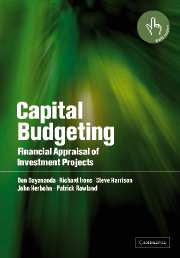Book contents
- Frontmatter
- Contents
- List of figures
- List of tables
- Preface
- 1 Capital budgeting: an overview
- 2 Project cash flows
- 3 Forecasting cash flows: quantitative techniques and routes
- 4 Forecasting cash flows: qualitative or judgemental techniques
- 5 Essential formulae in project appraisal
- 6 Project analysis under certainty
- 7 Project analysis under risk
- 8 Sensitivity and break-even analysis
- 9 Simulation concepts and methods
- 10 Case study in financial modelling and simulation of a forestry investment
- 11 Resource constraints and linear programming
- 12 More advanced linear programming concepts and methods
- 13 Financial modelling case study in forestry project evaluation
- 14 Property investment analysis
- 15 Forecasting and analysing risks in property investments
- 16 Multinational corporations and international project appraisal
- References
- Index
14 - Property investment analysis
Published online by Cambridge University Press: 14 May 2010
- Frontmatter
- Contents
- List of figures
- List of tables
- Preface
- 1 Capital budgeting: an overview
- 2 Project cash flows
- 3 Forecasting cash flows: quantitative techniques and routes
- 4 Forecasting cash flows: qualitative or judgemental techniques
- 5 Essential formulae in project appraisal
- 6 Project analysis under certainty
- 7 Project analysis under risk
- 8 Sensitivity and break-even analysis
- 9 Simulation concepts and methods
- 10 Case study in financial modelling and simulation of a forestry investment
- 11 Resource constraints and linear programming
- 12 More advanced linear programming concepts and methods
- 13 Financial modelling case study in forestry project evaluation
- 14 Property investment analysis
- 15 Forecasting and analysing risks in property investments
- 16 Multinational corporations and international project appraisal
- References
- Index
Summary
Property (or real estate) is any interest in land and its buildings. Purchasing or leasing a property is a capital budgeting decision that can be evaluated in the ways described in the preceding chapters. In many ways, the decision is no different to acquiring any asset that is expected to provide returns in the future. We apply all the usual principles of capital budgeting but there are some features of property investments and developments that require special care.
There are four main features of properties that distinguish them from most other assets. First, buying a property is an ‘all-or-nothing’ decision with limited choice at any time. Investors must often compromise in their search for the right property and yet the outlay is often the largest made by both private investors and businesses. Properties are not uniform, partial acquisitions are generally impractical and there are sizable transaction costs. Except for property developments, the only way to alter the scale of the investment is to change the financing arrangements.
A second distinction of properties is that each is financed separately, rather than drawing on a pool of company funds. Typically, the financing may be with a mortgage secured over the legal interest of the investor or company. This is one reason why the property and its financing are commonly evaluated together. This is a significant departure from the corporate approach explained in Chapter 2, in which it was pointed out that properties are commonly evaluated by working out their ‘equity’ cash flows.
- Type
- Chapter
- Information
- Capital BudgetingFinancial Appraisal of Investment Projects, pp. 251 - 273Publisher: Cambridge University PressPrint publication year: 2002



